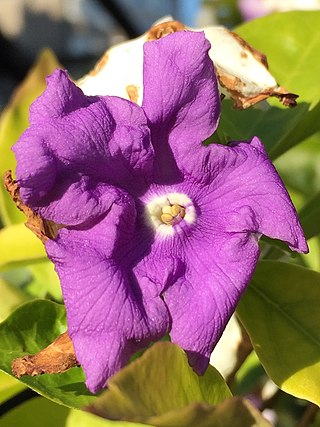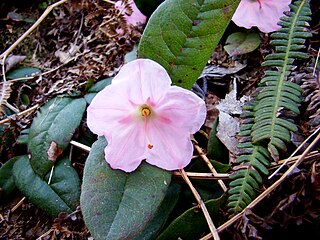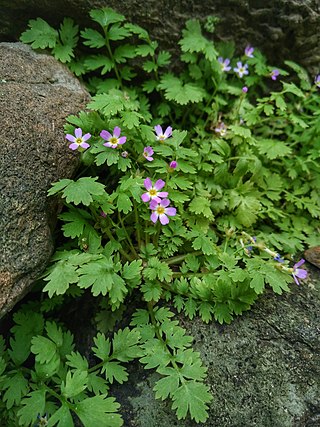
Solandra maxima is a flowering plant in the Solanaceae family. It is also known as cup of gold vine, golden chalice vine, or Hawaiian lily, is a vigorous vine which is endemic to Mexico and Central America. It has very large yellow flowers and glossy leaves. It is often planted as an ornamental plant.

Brunfelsia is a genus of flowering plants belonging to subfamily Petunioideae of the nightshade family Solanaceae. The 50 or so species have been grouped into the three sections: Brunfelsia, Franciscea and Guianenses, which differ significantly in both distribution and characteristics, although molecular data have revealed that only two sections are natural (monophyletic), namely the Caribbean section Brunfelsia and a common section for all South American species. Linnaeus named the genus for the early German herbalist Otto Brunfels (1488–1534).

Cinchona officinalis is a South American tree in the family Rubiaceae. It is native to wet montane forests in Colombia, Ecuador, Peru and Bolivia, between 1600–2700 meters above sea level.

Lobelia scaevolifolia is a species of the plant family Campanulaceae. It is endemic to the island of Saint Helena in the South Atlantic Ocean. It was at one time placed as the only species, Trimeris scaevolifolia, in the genus Trimeris. Its common name is St. Helena lobelia.

Macleania is a genus of plants in the family Ericaceae.
Barbieria is a genus of flowering plants in the legume family, Fabaceae. It contains a single species, Barbieria pinnata, a climber native to the tropical Americas, from southern Mexico through Central America and the Caribbean to northern South America.

Orphium is a plant genus in the Gentian family (Gentianaceae), endemic to South Africa. The name derives from the legendary Greek musician Orpheus. The genus contains a single accepted species, Orphium frutescens, commonly known as the sea rose. Orphium arenarium C.Presl has been proposed as another species, but data suggest that it is synonymous with Chironia arenaria E.Mey.

The Solanaceae, or the nightshades, are a family of flowering plants that ranges from annual and perennial herbs to vines, lianas, epiphytes, shrubs, and trees, and includes a number of agricultural crops, medicinal plants, spices, weeds, and ornamentals. Many members of the family contain potent alkaloids, and some are highly toxic, but many—including tomatoes, potatoes, eggplant, bell and chili peppers—are used as food. The family belongs to the order Solanales, in the asterid group and class Magnoliopsida (dicotyledons). The Solanaceae consists of about 98 genera and some 2,700 species, with a great diversity of habitats, morphology and ecology.

Epigaea gaultherioides is a species of flowering plant in the Ericaceae family. It is native to Transcaucasia and Turkey.

Scaevola plumieri is a species of plant in the family Goodeniaceae which grows on coastal dunes in the tropics and subtropics.

Atropanthe is a monotypic genus of flowering plants belonging to tribe Hyoscyameae of subfamily Solanoideae of the family Solanaceae.
Hawkesiophyton is a genus of flowering plants belonging to the family Solanaceae. It is also in Solanoideae subfamily, Tribe Solandreae Miers and also Subtribe Juanulloinae.
Nathaliella is a monotypic genus of flowering plants belonging to the family Scrophulariaceae. The only species is Nathaliella alaica. It is also within Tribe Scrophularieae.
Hanburia is a genus of plants in the tribe Sicyoeae of the gourd family, Cucurbitaceae. Its native range is from Mexico to Venezuela and Peru. It is found in the countries of Colombia, Costa Rica, Ecuador, Guatemala, Honduras, Mexico, Panamá, Peru and Venezuela.
Martinella is a genus of flowering plants belonging to the family Bignoniaceae. It is a genus of Neotropical lianas within the tribe Bignonieae.
Resia is a genus of plants in the family Gesneriaceae. They are also in the Beslerieae tribe.
Lycium cinereum is a shrub in the nightshade family (Solanaceae) indigenous to southern Africa. It is widespread across South Africa, as well as southern Namibia and Botswana.

Primula cicutariifolia, is a species of flowering plant within the genus Primula and family Primulaceae.

Primula clarkei is a species of flowering plant within the genus Primula and family Primulaceae. The species is endemic to the Western Himalayas, where it can be found in Poshiana of the Pir Panjal mountain range.

Primula wollastonii, also known as Wollaston's primrose, is a species of flowering plant within the genus Primula and family Primulaceae. The species was first discovered and collected by A. F. Wollaston during an expedition to Mount Everest in 1921. The plant would later be scientifically described by Scottish botanist Isaac Bayley Balfour, who named the species P.Wollastonii after a request from Wollaston who had first discovered it.












